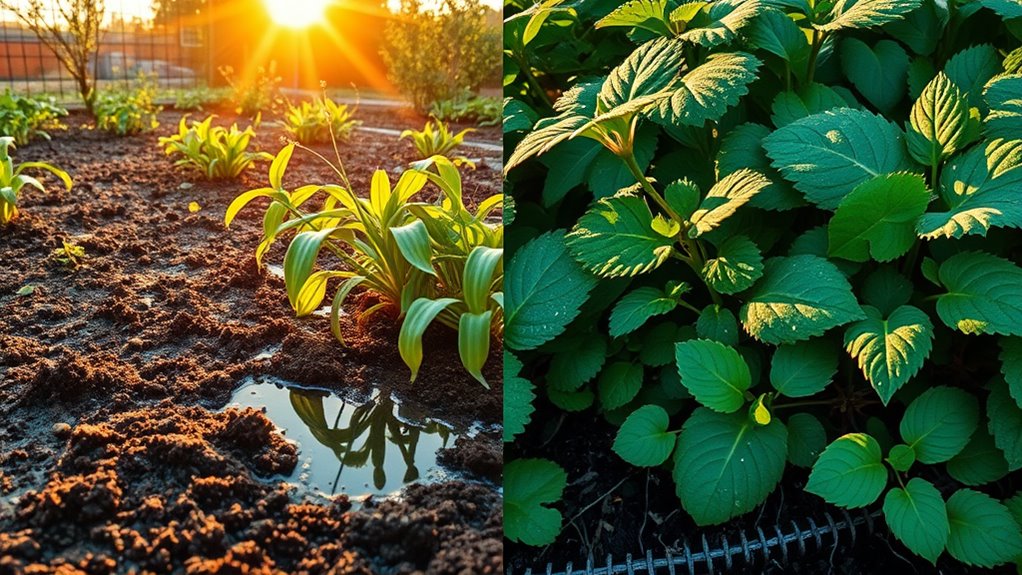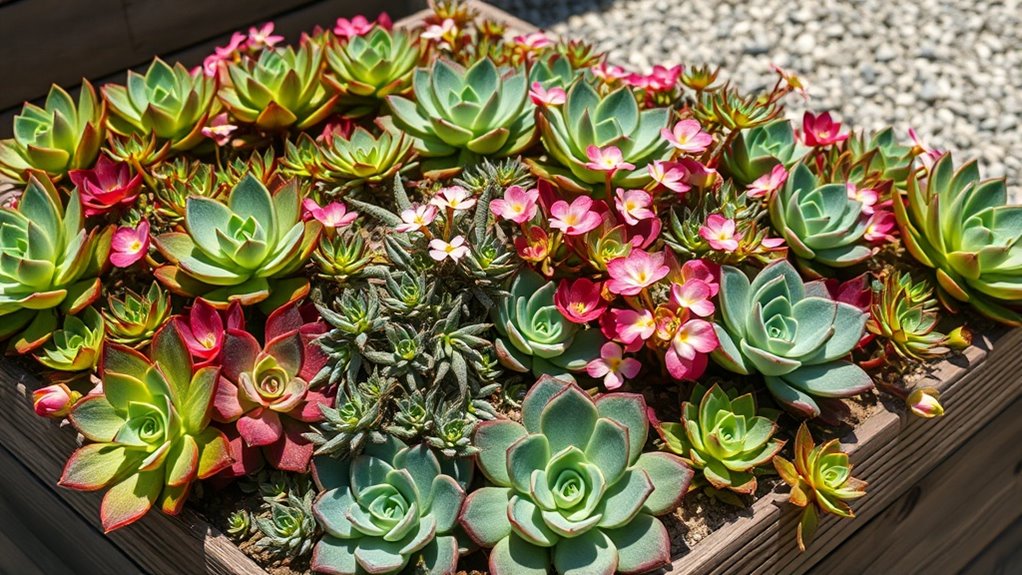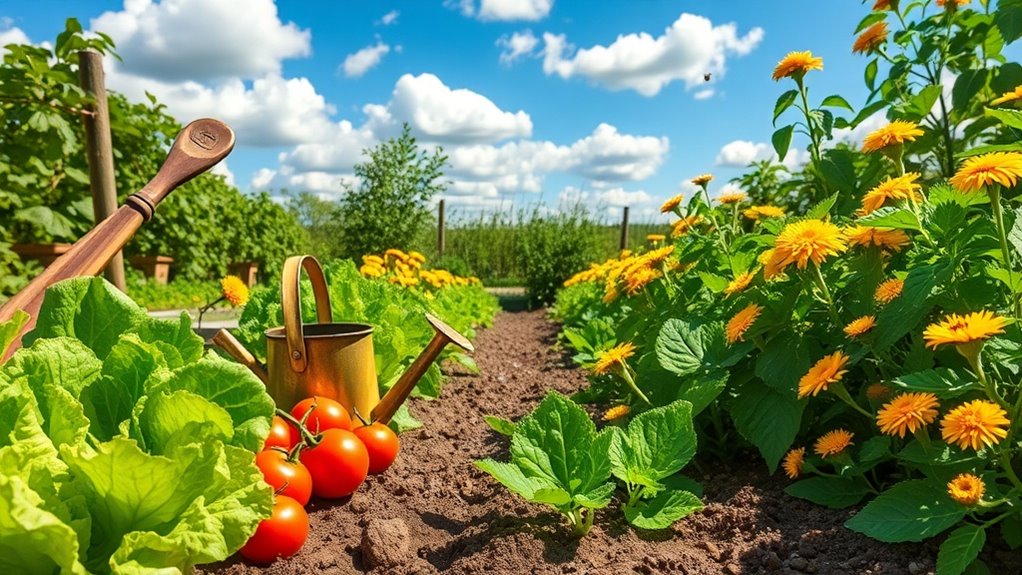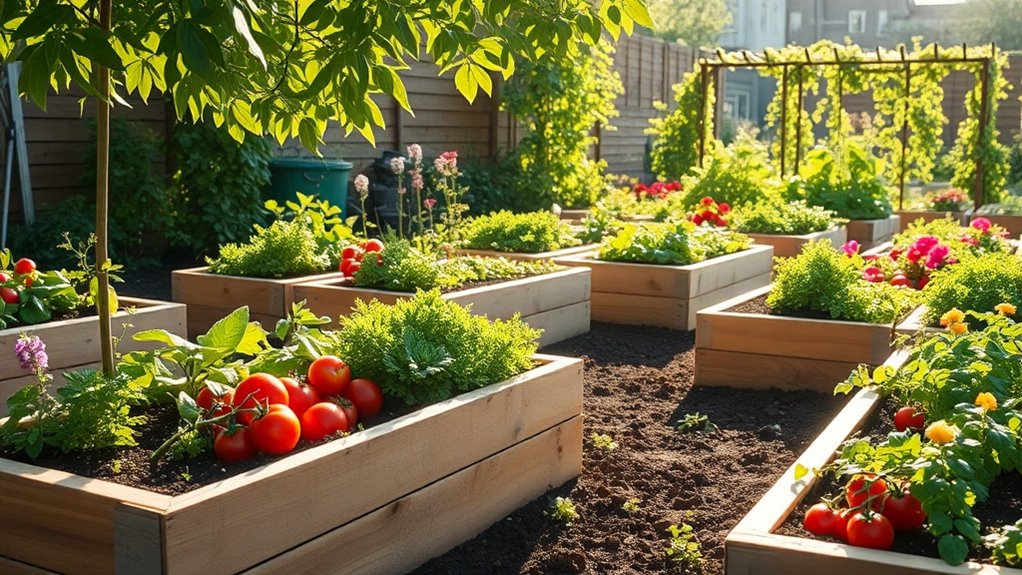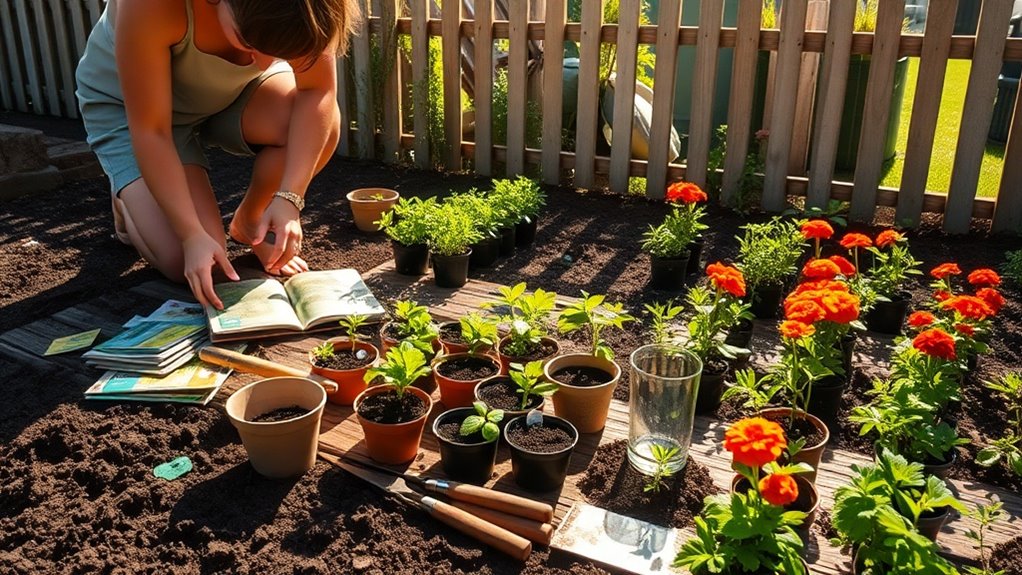Are You Watering Your Garden All Wrong. Here’s What Experts Do Instead
You’re probably watering your garden all wrong, overwatering and causing yellowing leaves or root rot, or underwatering and leading to wilting and stunted growth. Experts instead water early in the morning or between 4 PM and 6 PM to minimize evaporation and boost absorption, while checking soil moisture with a meter for precise needs. They use drip irrigation and mulch to deliver water efficiently and retain it longer. By spotting these signs early, you’ll keep your plants thriving—plus, pick up more strategies just ahead.
Key Takeaways
- Avoid overwatering by checking soil moisture; parched soil needs hydration, while soggy soil needs drying.
- Water in the early morning or evening to minimize evaporation and maximize plant absorption.
- Use drip irrigation to deliver water directly to roots, reducing evaporation by up to 50%.
- Apply mulch to retain soil moisture, cutting evaporation by 70% and suppressing weeds.
- Test soil regularly to detect nutrient imbalances and adjust watering for optimal plant health.
Common Watering Mistakes to Avoid
While it’s tempting to give your plants a daily soak, overwatering tops the list of common mistakes that can harm your garden.
You often overlook underwatering too, which stresses plants and stunts growth, as research from the Royal Horticultural Society confirms.
Effective watering tips involve checking soil moisture first—poke your finger in to feel if it’s dry an inch down. To reduce water loss, apply mulch layers around your plants.
Don’t water leaves; target roots to prevent fungal diseases. Use a soaker hose for even distribution, ensuring you promote deep roots and avoid shallow watering pitfalls, backed by extension service data.
Recognize signs of overwatering to better understand its effects on plant health and achieve the right watering balance.
Stay vigilant for healthier yields.
Optimal Times for Watering Your Garden
When you’re deciding on the best times to water your garden, you’ll benefit from choosing early morning, as it reduces evaporation and lets plants absorb moisture before the heat intensifies. Maximizing plant growth is another advantage of these timings, as they ensure efficient water use and promote healthier development.
Evening watering works well too, since it minimizes water loss and keeps soil moist overnight, based on studies showing lower evaporation rates.
These timing strategies are particularly effective in extreme heat, helping your plants remain hydrated and healthy as recommended in essential tips for such conditions.
Early Morning Watering
Early morning is the optimal time to water your garden, allowing plants to absorb moisture efficiently before the day’s heat sets in.
This timing minimizes evaporation, so you’re saving water while ensuring roots get what they need. Evidence from horticultural studies, like those from the Royal Horticultural Society, shows it reduces fungal diseases by letting foliage dry quickly under the rising sun.
You’ll promote deeper root systems and stronger growth. For practical results, use a soaker hose to target soil directly, watering deeply but briefly to avoid runoff and enhance plant vitality.
Evening Watering Times
Evening watering offers another effective option for your garden, as it reduces evaporation and lets plants absorb moisture during cooler hours.
For optimal results, you’ll want to water between 4 PM and 6 PM, giving soil time to hydrate without leaving foliage wet overnight, which minimizes fungal risks like mildew.
Studies from the University of California show this timing cuts water loss by up to 30% and boosts root development.
You’ll conserve resources by checking soil moisture first—use a meter—and directing water to the base of plants.
Experts from the Royal Horticultural Society confirm it promotes healthier, more resilient growth, making your garden thrive with less effort.
Determining the Right Amount of Water
You need to assess soil moisture regularly to avoid overwatering or underwatering your plants, using simple tools like a moisture meter for accurate readings. Additionally, monitoring soil signs can provide valuable insights into soil health, helping you adjust watering practices to prevent issues like nutrient deficiencies.
Next, calculate your plants’ needs by considering factors such as species, size, and local weather conditions, which research shows directly affect water requirements.
Furthermore, effective soil preparation can enhance water retention and support healthier plant growth by improving soil structure and adapting to environmental conditions.
Assess Soil Moisture
Assessing soil moisture accurately prevents overwatering and underwatering, which can harm your plants.
It’s essential to check before watering, using simple, reliable methods experts recommend. This ensures your garden thrives without waste.
-
Finger test: Insert your finger into the soil up to the second knuckle; if it feels dry, water your plants.
-
Moisture meter: Use a digital meter to get precise readings, avoiding guesswork.
-
Visual inspection: Look for cracks or a lighter color in the soil, indicating dryness.
-
Weight check: Lift pots; lighter ones suggest the soil is dry.
-
Feel the soil: Squeeze a handful; if it crumbles, it’s time to water.
Calculate Plant Needs
Once you’ve assessed soil moisture, determining the right amount of water for your plants ensures they thrive without harm.
Start by identifying plant types; vegetables like tomatoes need 1-2 inches weekly, while succulents require far less. Experts base calculations on factors like soil type, weather, and evapotranspiration rates—use local data for accuracy.
For instance, measure rainfall and adjust accordingly: if it’s dry, add an inch per week. You can use a simple formula—multiply plant size by daily needs—or a moisture meter.
This evidence-based approach prevents overwatering, fostering healthy roots and vibrant growth without waste.
Expert Techniques for Efficient Watering
How can gardeners optimize water use while keeping plants thriving? Experts focus on smart, evidence-based strategies that minimize waste and support plant health. Additionally, incorporating a DIY watering system can dramatically reduce the time spent on garden maintenance each week.
-
Adopt drip irrigation: Deliver water directly to roots, reducing evaporation by up to 50%, as studies show.
-
Water deeply and infrequently: Promote strong root systems by soaking soil thoroughly, encouraging deeper growth.
-
Mulch effectively: Cover soil with organic materials to retain moisture and cut evaporation by 70%, per research.
-
Time your sessions: Water early morning to avoid midday heat, maximizing absorption and minimizing loss.
-
Group plants wisely: Arrange by water needs to avoid overwatering, based on USDA guidelines for efficiency.
By implementing an innovative watering schedule, gardeners can further maximize efficiency, save water, and dramatically improve garden health and productivity.
Recognizing Signs of Improper Hydration
Recognizing signs of improper hydration in your garden is key to keeping plants healthy. If you’re underwatering, you’ll see wilting leaves, dry soil, and stunted growth, as roots struggle for moisture—evidence from horticultural studies shows this stresses plants and reduces yields.
Conversely, overwatering causes yellowing foliage, root rot, and mold, often due to poor drainage, according to experts at the University of California Agriculture and Natural Resources. For overwatered plants, implementing recovery techniques can help restore their health without causing further damage.
Act quickly: probe the soil; if it’s parched an inch down, hydrate thoroughly, but if soggy, allow it to dry to avoid damage. Monitoring prevents long-term harm.
By mastering effective techniques from experienced gardeners, you can achieve tripling vegetable yield through better hydration practices.
Essential Tools for Better Watering Practices
To tackle the signs of improper hydration you’ve spotted, you’ll want reliable tools that make watering more accurate and efficient.
These expert-endorsed options help you monitor and deliver water effectively, based on studies showing they reduce waste and promote plant health.
-
Soil moisture meter: Measures exact soil wetness to avoid over- or under-watering, backed by agricultural research.
-
Drip irrigation system: Delivers water directly to roots, minimizing evaporation as per efficiency studies.
-
Rain gauge: Tracks rainfall to adjust your routine, ensuring optimal hydration per meteorological data.
-
Soaker hose: Provides even, slow moisture penetration, improving absorption as recommended by horticulturists.
-
Watering timer: Automates schedules for consistency, supported by trials on plant stress reduction.
Additionally, for a more thorough approach to garden health, incorporating soil testing can reveal issues like nutrient imbalances that affect water uptake and overall plant vitality.
Strategies for Healthy Soil and Plant Moisture
Several key strategies can help you maintain healthy soil and optimal plant moisture, drawing from research in horticulture and soil science.
You’re starting by applying mulch, which studies from the University of California show reduces evaporation by up to 70%, keeping soil cooler and moister.
Test soil moisture regularly with a probe to prevent overwatering, as data indicates this avoids root rot.
Incorporate compost to boost organic matter; it improves water retention by enhancing soil structure.
Water deeply but infrequently, promoting robust roots that access moisture efficiently, based on USDA findings.
Furthermore, mulching enhances garden vitality through pest control, as it helps suppress weeds and fosters a healthier ecosystem.

